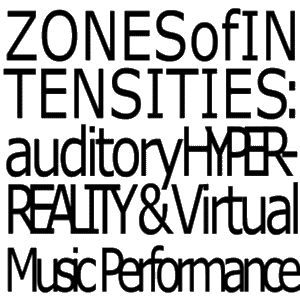|
|
MUSIC :ACOUSTIC :DIGITAL :VIRTUAL |
CONTACT | ||||
|
| ||||||
| ||||||||||||||||||||
|
VIRTUAL MUSIC PERFORMANCE Virtual Performance: a way of making things seem to be happening that are not. 
When I work on a new piece of music, whether in manuscript or in a digital studio, like almost every other composer in the world, I wonder if and how it will be performed and consider ways to do this. A significant problem for the relationship between composers and audiences is the general decline of concert-going. Most of us own an iPod or a music-playing phone. Since the Sony Walkman in the 1980s, private listening on the move has been a norm for millions of music listeners. There are still two cultures of music listening but live music listening, already a minority activity, continues to lose ground to digital media. If I want to hear Azeri mughams or the Louis Armstrong Hot Five or Richter playing Chopin, I have Youtube, iTunes, Spotify, Yandex, Bleep. . . A universe of free recorded music instantly available on demand to flick through, glance at, stockpile. . . but this can lack two crucial elements: For many reasons, both practical and aesthetic, composers are creating music in a digital format, and increasingly for sole release via download. My work is partly concerned with how to use the digital studio to extend the capacity both of our auditory credulity and the technical range of the imaginary performer. I can write music that sounds as if it is being played, even though it is impossible: it allows me to continue learning from the ancients, building upon, adapting, responding to the music of forebears and to create performances of music for one the most successful instruments ever invented, the piano. The compositional decision is now not whether it can be done, but entirely whether the composer thinks it will sound effective - one instructs the computer in minute detail how to render those notes, On instruments other than the piano, such as strings, this is far harder to achieve. Firstly of course, one must create a sound which the listener finds believable, convincing. If simulating an instrument, it must sound like one that a performer could actually play. So, dense, continuous un-spread chords on a simulated violin would sound bizarre, unrealistic and like something quite different from a violin. Our accustomed sense of what can be done on a violin is ingrained in even listeners of no musical training. So, realism of digital delivery depends on the performance being plausible - if a chord is sounded across the arched strings, it must be spread in live playing. Each note of the chord will have a slightly different attack, be held for a longer or shorter time and will ring more or less in sympathy (clearly) with the other notes according to the general intonation of the instrument, tuning of strings and other acoustical properties. It is so complex a task to simulate, not only violin performance but the tiny fluctuations that occur on any instrument - and each one sounds different from the next, in terms of resonance and responsiveness - that we have not yet achieved anything like realism in attempts to simulate them, although the potential for this approaches gradually closer. On the other hand, the piano already permits extensions of reality (almost) seamlessly into virtual experience. The piano's sound is characterised by a short attack followed by variable length sustain, depending on how long the note is held or the sustain pedal depressed. Technical feats may now be achieved at the virtual piano, that players of idiosyncratic brilliance like Erroll Garner and Art Tatum would be astonished by. The difficulty of the digital composer's task lies in achieving the complex subtleties that characterise such pianists: apparent mastery of a fluctuating, teasing route around the implicit beat that always returns in a way perceived to be bang on the nail - the ear is frequently deceived, perceiving accuracy and rigidity where there is in fact considerable fluidity. Too much accuracy quickly becomes dull, the wrong sorts of inaccuracy just sound wrong. So, the minute process of ironing, ruffling, sculpting out the humanoid curves of a digital performance is generally as complex and difficult as the composing itself. The conception, composition and performance of the music are now blurred. All stages, from the composer's intangible, incorporeal, half-remembered dream to the heard performance and the listeners' own new subjective memories of the music, are knotted, interdependent layers. This current work is all about the quest for new forms and structures, for music that exists in space only or simultaneously in space and time, compositions whose complexity and density is so wild and immense that no-one could ever hear the whole piece of music at once - and is obliged to inspect it a fragment at a time. Strides forwards in many diverse fields are making it possible now for new sounds to emerge from the musical vocabulary with which we are familiar, engendering warps and fluctuations of our auditory expectations, new expressive possibilities emerging from collisions and interweavings of the almost familiar, nearly remembered... But how is this music to be heard? On speakers, in a concert hall or pub venue? In the car? The challenge of giving a live performance of a digital work is enormous but very exciting and the experience is coming this way. Read more. . . Zones of Intensities: Auditory Hyper-Reality and Virtual Music Performance | ||
| | ||